“This exhibition looks at works of art which tackle the effects and consequences of established walls and barriers, both physical and ideological.”
The pictures on this page are from Walls and Margins, an exhibition organised by the Barjeel Art Foundation in 2015-2016. The images and accompanying notes come from the exhibition's online catalogue which contains further information and more examples.
Introduction by Suheyla Takesh, Curator
Soon after people learned how to lead a sedentary lifestyle, and began building permanent dwellings and settlements, the idea of a protective fence was developed. Devised as a security measure, it is a separation of what is in versus what is out, what is accessible versus what is off limits.
The fence, which was conceived of as a tangible, physical barrier, also introduced - and at times encouraged - the accentuation of ideological differences between inhabitants and outsiders, members and non-members. These differences could be apparent in the form of distinct languages, or varying, and often contradicting, belief systems, social structures, and political agendas. Protective fences gradually evolved into the notion of geographical borders, and a clear, formalised designation of national identities - i.e. a formal system of members and non-members.
At present, many barriers remain physical. These can be observed in the form of walls, bodies of water, or guarded national borders, which prevent or control the physical movement of people from one side of the enclosure to the other. In the past two decades, dividing systems have figured prominently in the construction of the world’s political landscape. These, among many others, include the continued construction of the Separation Wall in Palestine, the control exerted over Tangier’s citizens’ movement through the Strait of Gibraltar, and most recently, the barriers being erected in various parts of Europe and the Middle East in order to control the vast influx of war refugees.
Other boundaries, however, are intangible and manifest through differences in religious views, linguistic affiliations, and people's individual outlooks on subjects like politics or sexuality. Such obstacles - both physical and ideological - often lead to the exclusion from conventional society of various subcultures, minorities, and groups that deviate from the established norm - as is the case with many immigrants, exiles and people that are explicitly marginalised due to their religious or gender-related convictions.
This exhibition looks at works of art, which tackle the effects and consequences of established walls and barriers, both physical and ideological. It aims to highlight that while some of these dividing systems occur naturally, many are conscious human constructs, and ideas of us and them, inside and outside are often fabricated. As the sense of isolation that stems from being walled in or out is often encountered on an individual level, many of the works featured in this exhibition tell personal stories and provide private vantage points on larger issues.
Abdulnasser Gharem
b. 1973, Khamis Mushait, Saudi Arabia

Concrete Block II, 2010. Rubber stamps, wood sculpture 107 x 123 x 69 cm
Abdulnasser Gharem is a Lieutenant Colonel in the Saudi Arabian army as well as a conceptual artist. His practice includes photography, video, sculpture, and public interventions, and critically explores daily life and contemporary issues with a particular focus on themes of authority and control.
In Concrete Block II, Gharem honours the legacy of the French conceptual artist Marcel DuChamp, who famously selected and exhibited ordinary, readymade objects in museum settings. In this piece, Gharem transports to the gallery space a concrete roadblock, similar to those that can be found outside official Western buildings in the region. By isolating, and re-contextualising these everyday symbols of power, Gharem raises critical questions surrounding political alliances, foreign presence, and ultimately, civic trust.
An internationally recognised artist, Gharem has been exhibiting since 2004. He has since participated in exhibitions and biennales worldwide, including shows at the Victoria and Albert Museum in London (2012-13) and the Mori Art Museum in Tokyo (2012), the Venice Biennale (2011) and a solo exhibition in London (2013). In 2011, Gharem’s work set a record-breaking sale at Christie’s in Dubai, establishing Gharem as the highest selling living artist in the Gulf.
Gharem attended the King Abdulaziz Academy and the Leader Institute in Riyadh before studying art at Al-Meftaha Arts Village in Abha. He is the co-founder of the nonprofit arts organisation, Edge of Arabia. He lives and works in Riyadh.
Adel Abdessemed
b. 1971, Constantine, Algeria
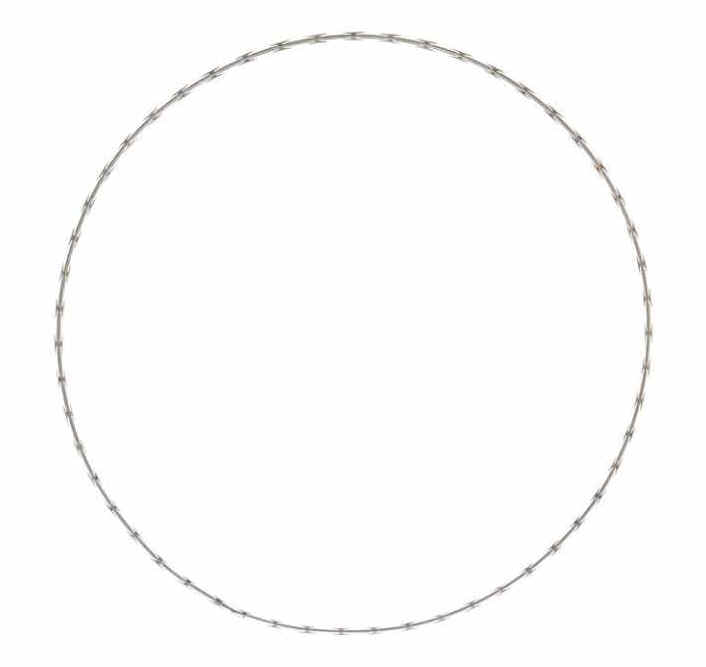
Sphere I, 2006. Metal razor wire 196.6 x 174.4 cm
Adel Abdessemed is a conceptual artist working in a range of media, including drawing, photography, performance, and installation. He is known for a body of work that transforms everyday materials and images into provocative commentaries on violence and spectatorship.Drawing on an array of historical and philosophical references, the artist creates works with multilayered meanings.
In Sphere I Abdessemed uses metal razor wire to construct a seemingly simple sphere. The metal razor wire conventionally used to erect barriers is, in this piece, used to also form an opening. Striking in its elegance, the piece jarringly hints at a lurking menace and the potential for violence. Both delicate and dictatorial, the installation conveys a sheer formal beauty that serves as a biting reflection on authority and commentary on the universality of ongoing struggles for power.
Abdessemed has been exhibiting his work since moving to Paris in 1999. Since 2000, he has participated in various international biennales and triennales, including the 2007 Venice Biennale and the 2012 Paris Triennale, in addition to having had numerous solo shows throughout the U.S., Europe, and the Middle East, including a 2008 exhibition at the Massachusetts Institute of Technology’s List Visual Arts Center and a 2012 exhibition at Centre Georges Pompidou.
Abdessemed attended the Beaux-Arts in Algiers from 1987-94. In 1994, political unrest in Algeria brought him to Lyons, France, where he continued his training at Ecole des Beaux-Arts. He completed his studies in Paris in 2000. A year later, he enrolled at the International Studio Program at P.S. 1 Contemporary in New York.
He presently lives and works in Paris.
Akram Zataari
b. 1966, Saida, Lebanon
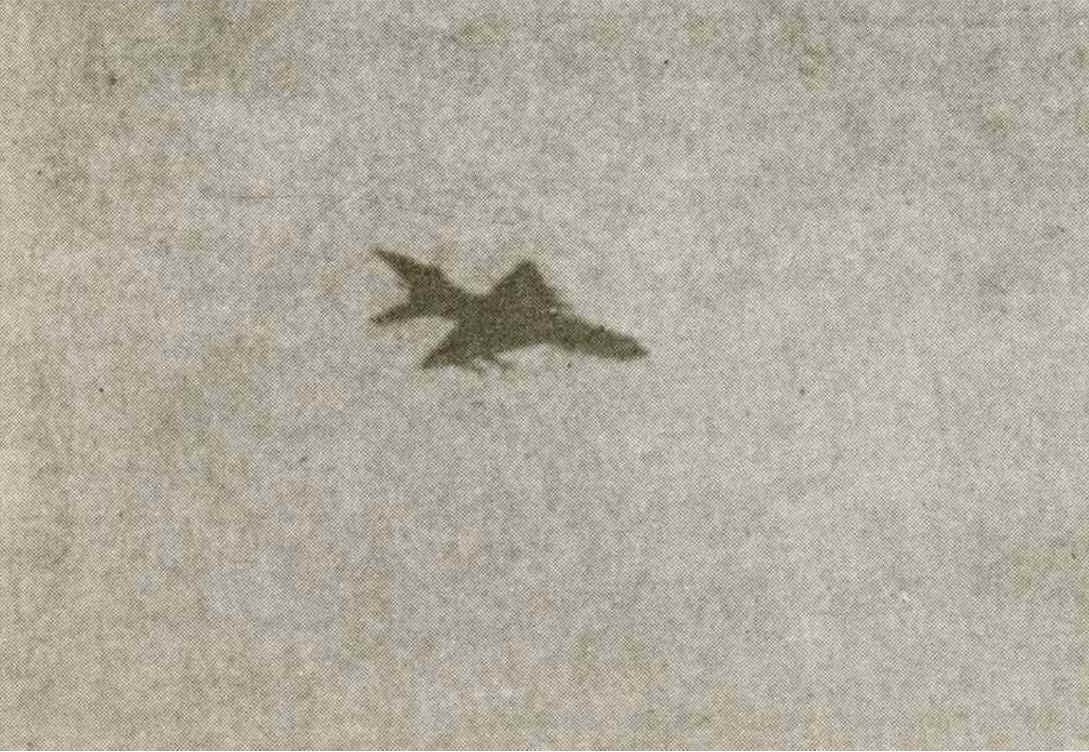
Untitled (Syrian MiG Fighter over Lebanon, 1982) 2014.Inkjet print on Hahnemühle paper 100 x 145cm
Akram Zataari is a filmmaker, photographer, and curator. Zataari is interested in collecting and re-contextualising a range of visual and textual documents that investigate the relationship between history and memory, particularly within the context of postwar Lebanon.
Untitled (Syrian MiG Fighter over Lebanon, 1982) is suggestive of Zataari’s interest in the intersection of visual imagery with technology and methods of surveillance. The image comes from archival material Zataari incorporated into his 2013 video and photographic installation for the Lebanese Pavilion in the 2013 Venice Biennale. The project, Letter to a Refusing Pilot, excavates a rumor that circulated in Zataari’s hometown regarding an Israeli pilot who, during the 1982 Israeli invasion, refused to hit his assigned target, instead dropping his bomb into the sea. Related, but itself an independent piece, Untitled (Syrian MiG Fighter over Lebanon, 1982) highlights the intimate stories often concealed within the historical materiality and measured distance of archival documents and official histories.
Zataari has exhibited in collective and solo shows worldwide and has received numerous residencies and awards, including the 2011 Grand Prize of the 17th International Contemporary Art festival in Sao Paulo.
In 1997, he co-founded the Arab Image Foundation, a Beirut-based photography archive.
Zataari received his undergraduate degree in architecture from the American University of Beirut and a Masters of Arts in Media Studies from the New School for Social Research in New York, NY. He lives and works in Beirut.
Asim Abu Shaqra
1961 - 1990, Umm al-Fahm
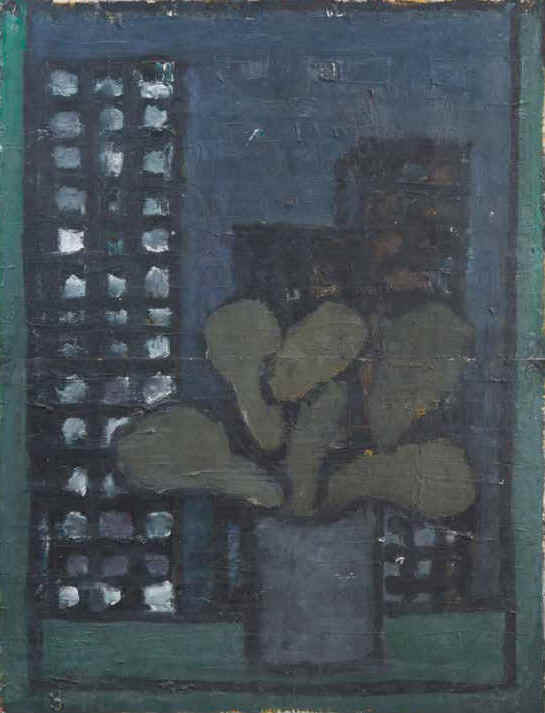
Cactus with City in the Background, 1988.Oil on paper 140 x 105 cm
Born into a family of artists, Abu Shaqra left his hometown in 1981 to study at the Kalisher Art Academy in Tel Aviv, graduating in 1986 and later teaching at his alma mater.
A painter, Abu Shaqra’s central motif was the sabra, or cactus. The artist often depicted this iconic symbol of Palestinian steadfastness as uprooted and planted in a flowerpot. Critics have often read Abu Shaqra’s domesticated sabras as self-portraits, reflective of the artist’s own displaced status as a Palestinian living and working in Israel.
Representative of Abu Shaqra’s larger body of work, Cactus with City in Background depicts a potted sabra on a windowsill that opens onto a nighttime urban-scape. The tall, vertical thrust of the buildings with their rhythmic windows, stand in contrast to the rounded, organic form of the cactus and highlight the plant’s unnatural interior confinement. A second painting, Beast, also centralises its main subject, isolating and alienating the animal form outside of his natural environment and depicts the subject with Abu Shaqra’s characteristically broad, sweeping brushstrokes and simple, yet bold outlines.
In 1988, Abu Shaqra held solo exhibitions at the Umm el-Fahm Gallery and Tel Aviv’s Rap Gallery. He continued to exhibit until his death in 1990. In honour of his prolific career, retrospectives of his work have been organised at the Israel Museum in Jerusalem (1991), the Helena Rubsenstein Pavilion for Contemporary Art at the Tel Aviv Museum (1994) and the Golconda Fine Art Gallery in Tel Aviv (2008).
In 2013, a monograph on Abu Shaqra was published by Nira Itzaki with an accompanying exhibition at Tel Aviv’s Chelouche Gallery.
Charbel-Joseph H. Boutros
b. 1981, Lebanon
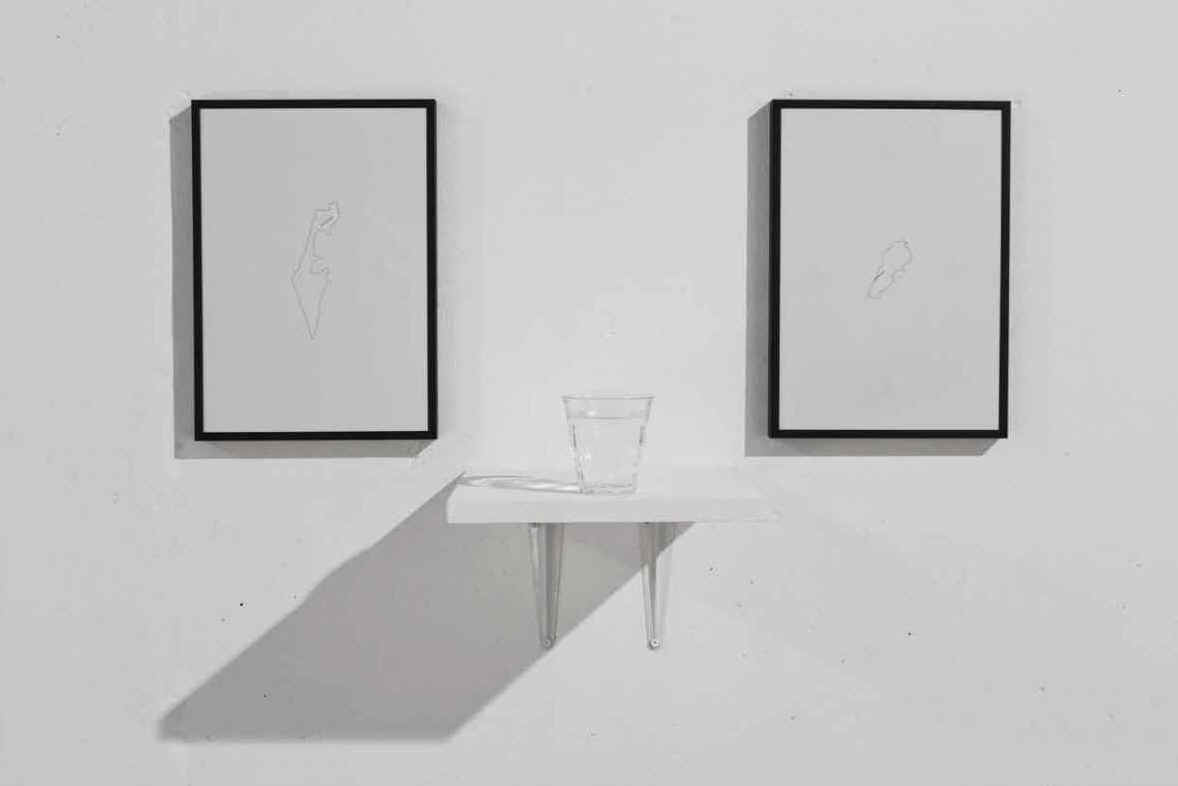
Mixed Water, Lebanon, Israel, 2013. Drinking glass, water - an equal mix of Lebanese mineral water (Sohat), and Israeli mineral water (Eden), wooden shelf, inkjet print on archival paper, painted nails 40 x 70 x 21 cm
Charbel-Joseph H. Boutros is known for his multi-disciplinary work.Inspired by the legacy of conceptual art, Boutros often takes a minimalist approach to his installations that are poetic in their visual simplicity, yet intricate in their investigation of conceptual ideas.
The Sun is My Only Ally is part of a series of works that activates the sun in the artistic process. The title, written with a stencil system, is made visible on the paper in pale yellow after being exposed to UV rays. Referencing the history of photography (the Greek word that means ‘to write with light’), Boutros illuminates the role of science and nature as integral to the artistic process. The juxtaposition of the work’s stark literalness and poetic beauty emanates from the piece, Mixed Water, Lebanon, Israel. A framed map of Lebanon and one of Israel are mounted on either side of a small wooden shelf that holds a small glass filled with equal amounts of mineral water from Lebanon (Sohat) and Israel (Eden). Visually distilling the complexity of the issue, Boutros creates a sense of estrangement in the viewer that is paradoxically more powerful than the standard media representation of an often violent conflict.
Boutros’ work has been exhibited in biennials, galleries, and museums worldwide, including solo shows at Grey Noise in Dubai (2014) and Palais de Tokyo in Paris (2015). He has been awarded residencies in Maastrict, Sao Paulo, Paris, and Tokyo. His work has been collected by Bonnefanten Museum in Hedge, House Collection in Netherlands, and the Dutch Ministry of Culture.He lives between Beirut, Paris, and Maastricht.
Djamel Tatah
b. 1959, France
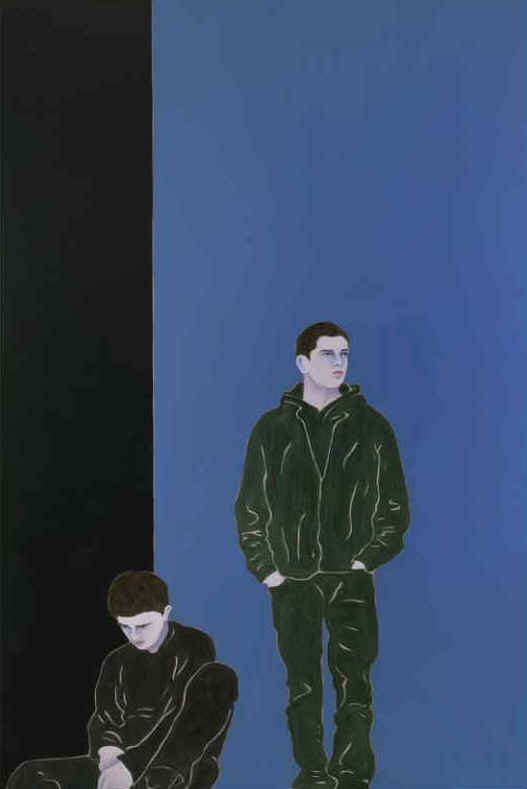
Untitled, 2012.Oil and wax on canvas 300 x 200 cm
Djamel Tatah is a painter of Algerian heritage, working using a technique of wax painting and photography, in addition to digital technology. The artist is best known for his distinctive canvases that depict anonymous, life-sized figures set against monochromatic coloured canvases, suggestive of geometric abstractions. Using minimal narrative detail, Tatah creates works that are visually striking in their simplicity.
In Untitled, Tatah portrays two young men, one seated and another standing. The figures’ physical proximity is juxtaposed with their emotional disengagement from one another, highlighted by a background that is starkly divided into blue and black. Tatah’s choice of bold colours offers a sharp contrast to the silence between the two young men that permeates the composition. Although both the figures and their location are anonymous, their posture and facial expressions suggest an emotional narrative that conveys a sense of boredom and estrangement among disenfranchised youth.
He studied at Beaux-Arts School of Saint-Etienne from 1981-86. Tatah has participated extensively in collective exhibitions throughout Europe, as well as in China, Russia, Palestine, and Algeria. In 1989, he held his first solo exhibit when he moved to Marseille. Since then, he has held solo shows at galleries and museums throughout France and Europe, including a 2013-14 retrospective at the Marguerite and Aime Maeght Foundation accompanied by a monograph on the artist, in collaboration with the Museum of Modern and Contemporary Art of Algiers.
The artist lives and works in Bourgogne.
Driss Ouadahi
b. 1959, Casablanca, Morocco
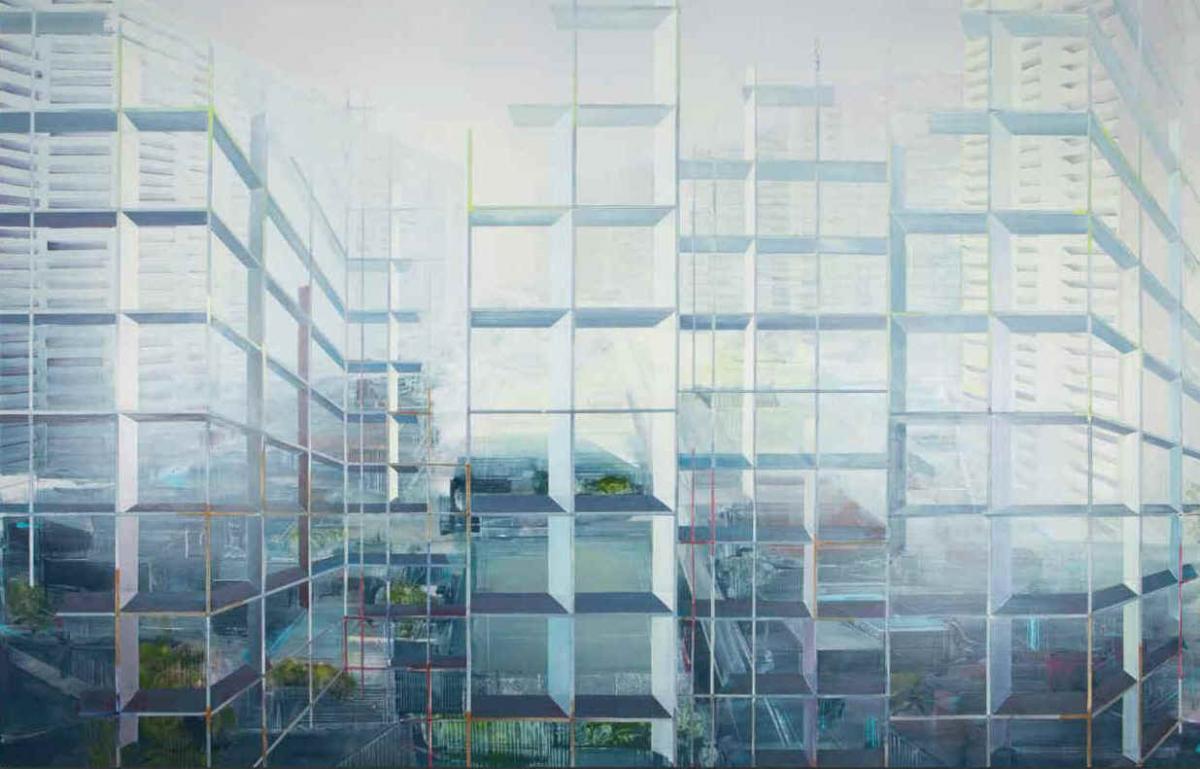
Vue d’ensemble, 2013. Oil on canvas 160 x 240 cm
Driss Ouadahi is an artist of Algerian heritage who moved to Kabiliya at the age of four and lived there for nine years, then moving to Algiers.
An architect and artist, Ouadahi is most recognised for his large-scale oil paintings that collage the architectural language of modernity — high rise buildings, parking lots, fences, and metro passageways — into anonymous urbanscapes. Once symbols of modernisation and technological achievement, Ouadahi’s abstracted modernist forms now convey a sense of urban dislocation and alienation.
Vue d’ensemble and Zinnober represent a body of work that Ouadahi began by painting public housing in Algiers. Modeled on France’s housing at fixed prices for immigrants from the former colonies, the public housing in Algiers housed displaced and formerly rural populations. Ouadahi’s cityscapes of steel, glass, and concrete — the materials of modernism — are often geographically non-descript, yet, speak to the politics of class and ethnicity associated with failed promises of modernity.
Ouadahi has exhibited in solo shows throughout the U.S. and Europe, in addition to numerous group exhibitions. Recent exhibitions include 11th Biennale de L’Art Africain Contemporain in Dakar, 25 Ans de Creativite Arabe at Institute du Monde Arabe, and in the Future of a Promise at the 54th Venice Biennale. He studied architecture in Algiers (1979-82) and art at Ecole Superieure des Beaux-Arts d’Algiers (1984-87) before continuing his training and graduating from the Kunstakadamie Dusseldorf (1988-94).He lives and works in Dusseldorf, Germany.
Fadi al-Hamwi
b. 1986, Damascus, Syria
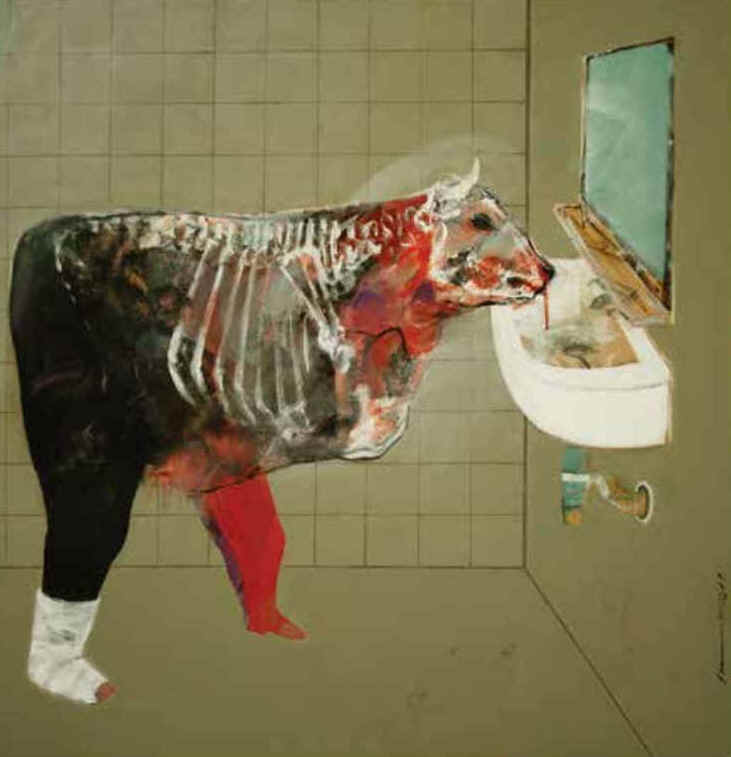
Bathroom Mirror, 150 x 150 cm, Acrylic on canvas, Beirut, 2014
Fadi Al-Hamwi is known for his work primarily as a painter, although he also works in installation and video. He is most recognised for his eerie portraits of animals isolated against a background of swirling dark, gray colours that offer poignant commentaries on the reality of life experienced under the current violence in Syria.
The painting Clean Teeth and mixed media work Checkpoints both exhibit Al-Hamwi’s characteristic depiction of his subjects, as if viewed through an X-ray machine. In the former work, the cow’s disembodied teeth and missing front legs offer a sad, surrealist image suggestive of the absurd reality of life under the war in Syria. Through its choice of title, Checkpoints offers a more direct reference to the continuing violence in Al-Hamwi’s homeland. In this work, the X-ray reveals the inside of a suitcase: a small body cramped in a fetal position against a grid of blue glitter blocks, indicative of smuggled blocks of gold or money. Here, the X-ray technique reveals the hidden realities of political strife in the form of contraband, a glittering promise that attempts to conceal the tragic human cost of war.
He graduated in 2010 from the department of painting and drawing in the Faculty of Fine Arts at the University of Damascus. Since 2007, Al-Hamwi has been exhibiting throughout Syria, Lebanon, and the UK, including a solo show in 2012 at Art House Gallery in Damascus.He currently lives and works in Beirut, Lebanon.
Layan Shawabkeh
1986-2009, Jerusalem, Palestine
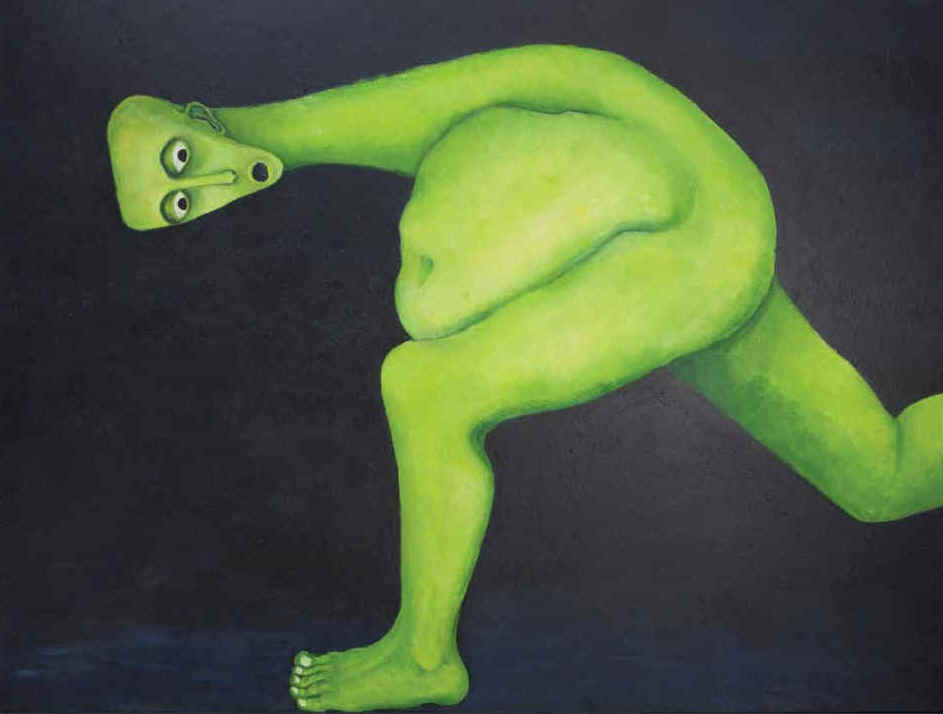
Barzakh (Purgatory), 2008. Acrylic on canvas 145.5 x 190 cm
Layan Shawabkeh was a painter whose distinctive compositions are expressive of the violence, vulnerability, and victimisation that characterises Palestinian life under the Israeli Occupation. Her works focus on the female form, which often symbolises the homeland. The women in Shawabkeh’s canvases are depicted in tormented physical and psychological states, suggestive of the State of Palestine.
Barzakh belongs to the series Ladies of Gaza, inspired by Picasso’s famous painting, Les Demoiselles d’Avignon, as well as media images of distraught Palestinian mothers confronting the loss of a child due to violent assault. Depicting the female body through angular, distorted lines, Barzakh utilises the physical body to convey a psychological state of extreme pain and suffering—a body that stretches beyond the canvas, bending over to protect her swollen belly. The artist’s choice of luminescent greens and yellows set against a dark background furthers the sense of alienation that characterises the continual losses suffered by Palestinians.
Shawabkeh was an internationally operating emerging artist whose work was recognised in 2008 when she received the AM Qattan Young Artist of the Year award. She studied at the International Academy of Art, Palestine. In 2009, Shawabkeh tragically lost her life to cancer.
Manal al Dowayan
b. 1973, Ash-Sharqiyah, Saudi Arabia

Strictly Families Only, 2006.Archival giclée prints mounted on dibond, spray paint 101 x 152 cm
Manal Al Dowayan is a mixed-media artist whose photographic and installation-based practice is reflective of the contemporary social and cultural role of women in Saudi Arabia.
Strictly Families Only is part of a series entitled And We Had No Shared Dreams. Influenced by the writings of Palestinian novelist Dr. Sahar Al Khalifa and Saudi poet and politician Dr. Ghazi Al-Gosaibi, this photographic series imagines a conversation between a city and its inhabitants. Through black and white urbanscapes, which have an overlay of words and images that are superimposed with lights, buff-proof spray, and ink, the artist brings into focus life within the margins of the city.
Al Dowayan has been exhibiting internationally in shows and biennales since 2003, including in the 2011 Venice Biennale. She has received worldwide recognition for her work, including residences at the Mathaf: Arab Museum of Modern Art (2014), NYU-Abu Dhabi (2014), and the Robert Rauschenberg Foundation (2015).
Born in Ash-Sharqiyah, the Eastern province of Saudi Arabia, Al Dowayan received a Master’s degree in System Analysis and Design. She worked for ten years as the creative director of an oil company before dedicating herself to her art practice. She studied photography in Saudi Arabia, Dubai, Bahrain, and London.Al Dowayan lives between the United Arab Emirates and Saudi Arabia.
Nadia Ayari
b. 1981, Tunis, Tunisia
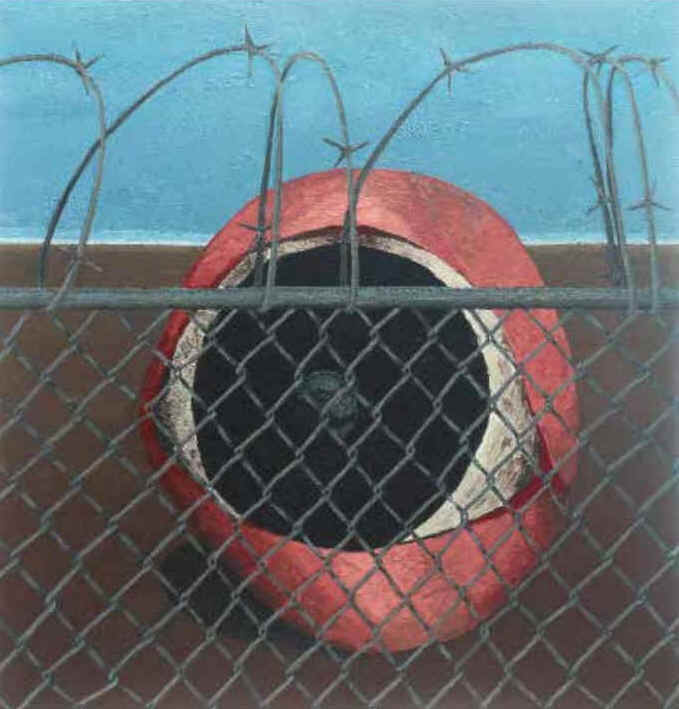
The Fence, 2007. Oil on canvas 152.5 x 142.3 cm
Nadia Ayari is best known for her distinctive paintings that are characterised by striking balance between abstraction and narration. Often working in a series, Ayari focuses on a select number of protagonists to relate a story. Her protagonists often take the form of a disembodiment (an eye, tongue, or finger) or isolated form (a fig leaf). Setting her characters against densely painted, semi-abstracted landscapes, Ayari creates compositions that are rich in both their formalism and political commentary.
In Fence, a disembodied eye stares blankly from behind a barbed wire chain fence. With its calm blue sky and bare, isolated landscape, the composition conveys a stillness that stands in stark contrast to subject of imprisonment. Creating an image that is at once cartoonish and threatening, Ayari uses the cultural icon of the eye to comment on contemporary issues of identity and surveillance.
Ayari moved to the U.S. in 2000 and received a B.A. in art history form Boston University, a M.F.A. in painting from the Rhode Island School of Design, and a certificate of fine arts from Brandeis University.
She began exhibiting her work in 2008, and has participated in numerous international shows and biennales, including the 12th Cairo International Biennale, U.S. pavilion and the 3rd Thessaloniki Biennale. She has participated in residencies at Skowlegan School of Painting and Design, Fine Arts Work Center and AiR Dubai. Ayari also co-directs S 2A, a New York-based project space and collective.Ayari currently lives and works in Brooklyn, New York.
Steve Sabella
b. 1975, Jerusalem, Palestine

Metamorphosis, 2012. Light jet print on diasec 3.5 cm aluminium box edge 180 x 180 cm
Steve Sabella works in large-scale photography and photographic installations, often created in a series and explores the experience of exile, notions of fragmentation, displacement, and metamorphosis, thereby challenging the perception of fixed identities.
In Metamorphosis, Sabella gives visual form to the dislocation of exile. An immediate reference to the Wall built by the Israeli government in the West Bank along the 1949 Green Line, Sabella’s image transforms the barrier into a captivating and dizzying labyrinth.
Through a technique of layered repetition, the artist spatially flattens the image. Closing off any possibility of spatial escape, the image uses visual abstraction to offer a powerful political critique of Palestinian life under the occupation.
He received a degree in photography from Musara School of Photography in Jerusalem in 1997. He continued his studies at Empire State College of State University of New York, where he received a B.A. in visual studies in 2007. In 2008, he was awarded a M.A. in photographic studies at University of Westminster and in 2009 a M.A. in art business from Sotheby’s Institute of Art.
Sabella has been featured in exhibitions and biennales worldwide, including 11 solo shows in Palestine. He has received numerous awards and fellowships, including the 2002 A.M. Qattan Foundation’s Young Artist of the Year Award and the 2008 Ellen Auerbach Award from Akademie der Kunste, Berlin. He is also a writer and regular contributor to the journal, Contemporary Practices.Sabella lives and works in Berlin, Germany.
Suleiman Mansour
b. 1947, Birzeit, Palestine
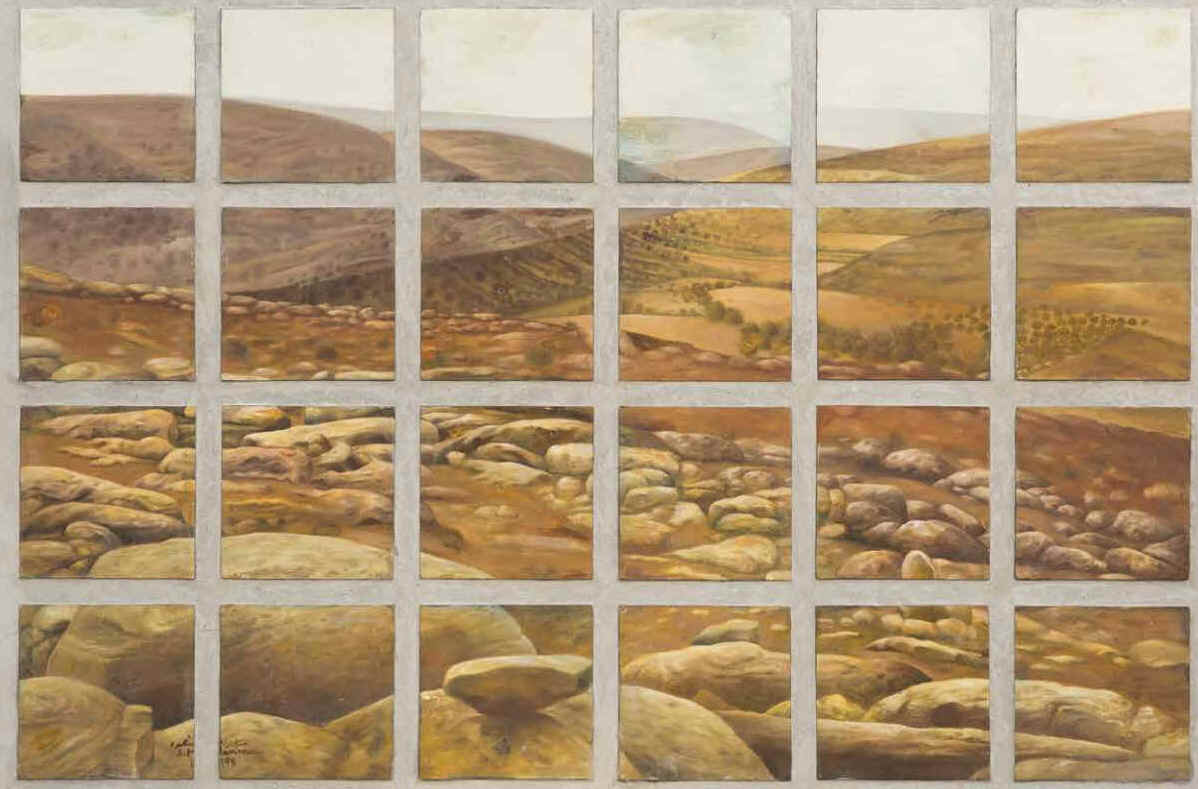
From Birzeit, 1998. Oil and concrete on wood 100 x 147 cm
Suleiman Mansour is a mixed media artist who is best recognised for his development of iconography on the Palestinian struggle, which he has been working on since the 1970s. Uniting Mansour’s body of work is the depiction of the orange tree (considered to symbolise the 1948 Nakba), the olive tree (considered to symbolise the 1967 war), traditional Palestinian embroidery, village life, and the figure of the Palestinian woman as giving birth and protecting the Palestinian people.
From Birzeit portrays the landscape from behind a concrete grid barrier. Unlike the conventional genre of landscape painting in which the land is on display for the viewer’s gaze, Mansour’s piece situates the viewer in the position of the Palestinian – barred from visual and physical access to the land. Offering direct political critique of geopolitical borders, Mansour visualises both the beauty of the land and the Palestinian struggle in all its hardships and aspirations.
Mansour studied fine arts at Bezalel Art Academy in Jerusalem and has exhibited in group and solo exhibitions throughout the Arab world, United States, Europe, and Asia. Notably, he participated in the 1997 French Palestinian spring exhibition at the Institut du Monde Arabe in Paris. He is the recipient of numerous awards, including the ‘Nile Award,’ at the 1998 Cairo Biennial. He was the head of the League of Palestinian Artists (1986 to 1990) and cofounded al-Wasiti Art Center in East Jerusalem (est.1994). He is a member of the Founding Board of Directors of the International Academy of Art Palestine.
Susan Hefuna
b. 1962, Cairo, Egypt
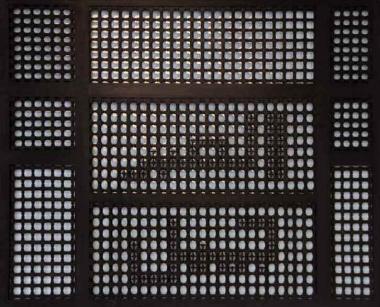
Al Sabr Gamil (Patience is Beautiful) 2007.Ink stained on wood 140 x 170 cm
Susan Hefuna is a German-Egyptian artist whose practice incorporates a diversity of mediums, including drawing, photography, sculpture, installation, video, performance, and textile-based works. She is most recognised for her body of work that examines visual and cultural signifiers of identity, with a particular interest in architecture from the Arab world and public space.
Al Sabr Gamil (Patience is Beautiful) documents Hefuna’s long-term interest in the mashrabiya, a traditional window screen of carved wood lattice found in Islamic and Arab architecture. Highlighting the abstract patterning that both reveals and obscures, Hefuna plays with notions of seeing and being observed. In these works, she often inscribes English and Arabic words and aphorisms within the holistic piece. Her focus on the detailed patterns of the lattice situates her work within two seemingly distinct histories: that of traditional architecture in the region and European modernism’s interest in abstraction.
Hefuna has extensively exhibited both in group and solo exhibitions worldwide, including a major solo show organised by the Sharjah Art Foundation (2014). She has received a number of prestigious awards, including the International Award at the Cairo Biennial (1998) and the Contemporary Drawing Prize by the Daniel and Florence Guerlain Foundation in Paris (2013).
Born in Cairo, Hefuna moved to Graz, Austria at the age of eight. She received a post-graduate degree from the Institute for New Media at the Stadelschule in Frankfurt, Germany (1992). She now lives and works between Egypt and Germany.
Yto Barrada
b. 1971, Paris, France
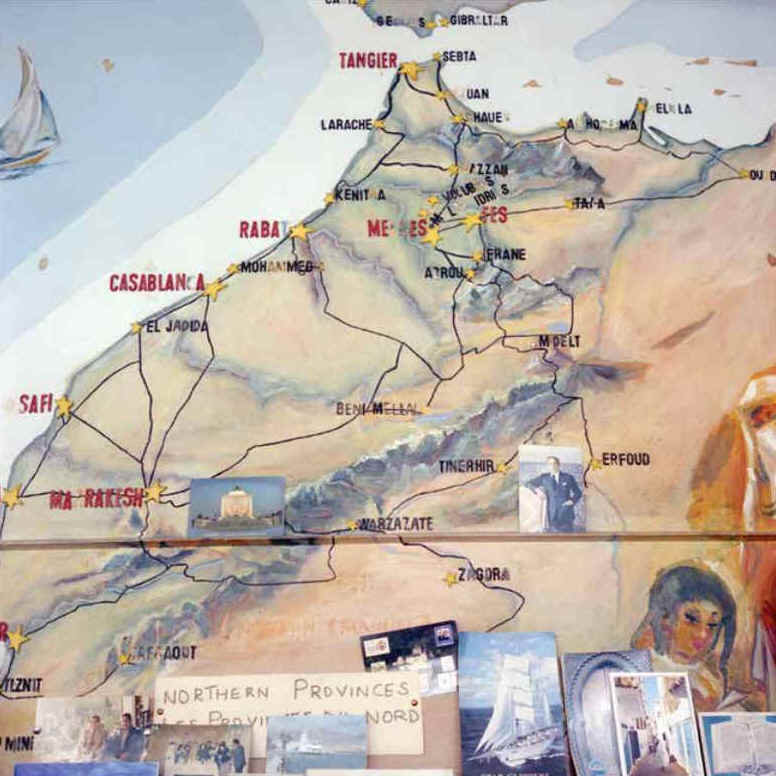
Northern Provinces, Tangier, 2009. C print 80 x 80 cm
Yto Barrada is best known for her socially and politically engaged practice that examines physical, national, and conceptual boundaries, with a particular emphasis on those between Morocco and Spain. Since the late 1990s, her hometown of Tangier has been her primary focus, examined through photo and video installations, sculptures, and site-responsive interventions.
Northern Provinces, Tangier continues Barrada’s exploration of the Strait of Gibralter, the narrow strip of sea separating Africa from Europe, the Mediterranean from the Atlantic, and where Tangier is located at the western entrance. This geopolitical position serves to both connect and separate Morocco and Spain. In 1991, the European Union’s Schengen Agreement created a unified European zone to protect the circulation of goods and people inside it, thereby partitioning bodies into the legal categories of “inside” and “outside.” In this piece, the harsh realities of the border city of Tangier are abstracted into a map — the ultimate representation of distanced control and surveillance — and thus suggestive of an additional boundary between legal discourse and its consequential lived reality.
Barrada has exhibited worldwide, including shows at the Witte de With, Fundacio Tapies, Jeu de Paume, MoMA in San Francisco and New York, Centre Pompideu and the Venice Biennale. She has received numerous awards, including the first Ellen Auerbach Award in Berlin (2006), Deutsche Artist of the Year (2011), and the Abraaj Prize (2015). She is the co-founder of Cinematheque de Tangier.
Barrada grew up in Tangier, Morocco and received a degree in history and political science at the Sorbonne before studying photography at the International Center of Photography in New York.
She divides her time between Tangier and New York City.


